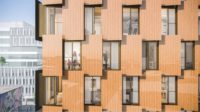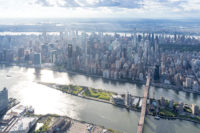Newsmaker: Marsha Maytum on the Architect as Advocate

Marsha Maytum is a founder of Leddy Maytum Stacy Architects (LMSA), a San Francisco-based firm known for buildings that address some of today’s thorniest issues, including social inequity, homelessness, universal access, and the climate crisis. With her husband, Bill Leddy, and their partner, Richard Stacy, she has built a firm widely recognized for its thoughtful, community-focused designs. Among LMSA’s many honors are the 2017 AIA Architecture Firm Award and 11 AIA COTE (Committee on the Environment) awards. Along with Leddy and Stacy, she recently published Practice with Purpose: A Guide to Mission-Driven Design. Earlier this year, Maytum announced that, due to a diagnosis of ALS, she will be stepping away from her day-to-day duties at LMSA, but will mentor and advise the firm as principal emeritus and will continue her environmental and social justice advocacy. RECORD deputy editor Joann Gonchar spoke with Maytum during a visit in San Francisco.
I’ve covered many of LMSA’s buildings, but I don’t know the firm’s origin story.
Richard, Bill, and I have been working together since the early 1980s. We found that we had similar values and a similar perspective on architecture. We also found that the projects that brought us the most fulfillment were related to issues that were important in our community. We all started with Tanner & VanDine. Then, in 1989, the firm was restructured as Tanner Leddy Maytum Stacy, and then, in 2001, it became Leddy Maytum Stacy. One of our priorities was the environment, and we really wanted to focus on that work. It was a tricky time—during the dot-com bust. But we’ve made it over 20 years.
In your book, you say, “At the practice scale, advancing equity, diversity, and inclusion starts with choosing who we work with and what we work on.” How have you positioned your firm so that you can select your clients and projects?
We get that question a lot. The explanation is that we were committed to our vision and made choices that allowed us to remain focused on mission-driven work. There are many ways to practice architecture, but, if you have a shared vision, it will propel you through your decision-making processes and economic ups and downs. One of the things we’ve done that has allowed us to maintain our focus is keeping the size of our office small and nimble.
Many of your projects have multiple stakeholders. Your supportive-housing projects, for instance, often have more than one developer, as well as the residents of the building and those of the surrounding neighborhood. How do you satisfy all their interests?
That’s one of the challenges of working in the Bay Area. We call it hyper-democracy, because everybody has a voice. But learning about all the different viewpoints, and understanding how they relate or don’t, is what makes this work super-interesting. It just takes a lot of time and effort. But it’s what makes the buildings better—if it goes right.
Can you point to one example in particular?
Berkeley Way is a project that includes about 90 units of affordable family housing, 50 units of permanent supportive housing for the formerly unhoused, a 30-person men’s shelter, housing for 12 formerly homeless vets, a community kitchen, and wraparound support services. It was built on a city parking lot, with city funding, by a partership between a nonprofit housing developer and a nonprofit service provider. But interviewing the veterans and talking to people around the shelter, and taking into account the nonprofit organizations’ experience, the city’s needs, and neighborhood concerns about scale and project type, has produced a building that everybody is thrilled with. We worked with the whole funding array that we have in California. We took advantage of density bonuses. It was one of four Bay Area projects participating in a low-carbon concrete pilot program. The building achieved GreenPoint Platinum. That’s another layer of the design that’s super-important, not just for energy and carbon, but for the health of the inhabitants. It was 2014 when we started with programming, and it was just finished in September. That gives an insight into all the many parts that need to fit together.

Berkeley Way provides affordable and supportive housing. Photo © Bruce Damonte, click to enlarge.
You were a key champion of the 2019 AIA resolution on climate action. Now that it has been adopted, what are the next steps? How can architects address global warming at the scale and speed required without being overwhelmed or discouraged?

The Ed Roberts Campus is home to several organizations serving the disabled. Photo © Tim Griffith
The sense of being overwhelmed and just giving up is a recurring theme that we hear about. But as architects, we do have power in this situation because we can help design the change. Sharing successful case studies is invaluable, because the first thing that people say [about design that responds to the climate crisis and social issues] is, “Oh, that’s impossible. You can’t do it. That’s only for a small number of clients.” So, as a profession, we have to show that it can be done. We wanted our book to be a guide, to lay out the approach that has worked for us.
In terms of examples, there is the Ed Roberts Campus, [the home of several organizations serving people with different kinds of disabilities, in Berkeley] and Sweetwater Spectrum [a residential community in Sonoma for people on the autism spectrum], which address both equity and social justice issues, integrating them with health and sustainability. The Fort Mason Center of Arts & Culture [the conversion of a historic pier building on San Francisco’s waterfront] is a great story about reuse and preserving not only the carbon in the building, but also the culture, keeping us connected to the past and to history. Adaptation will be essential. We really have to look at the building stock that we have and how we can reuse it.

Sweetwater Spectrum is residential community for adults with autism. Photo © Tim Griffith

The Fort Mason Center for Arts & Culture reuses a onetime Army warehouse. Photo © Bruce Damonte
One thing that we’ve been thinking a lot about is the infrastructure bill. There’s immense possibility with those funds to work with cities, states, and counties and help people know that there is money available to do this work. Architects can be advocates. We have a lot of power that we should use effectively. It’s an opportunity as well as a responsibility. That’s what our profession is all about: health, safety, and welfare—and beauty.




